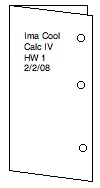| Day | Date | Topic |
| 1 | 1/25/10 | 10.1 Three Dimensional Coordinate Systems |
| 2 | 1/27/10 | 10.2 Vectors |
| 3 | 1/29/10 | 10.3 Dot Product |
| 4 | 2/1/10 | 10.4 Cross Product |
| 5 | 2/3/10 | Con't |
| 6 | 2/5/10 | 10.5 Equations of Lines and Planes |
| 7 | 2/8/10 | Con't |
| 8 | 2/10/10 | 10.6 Cylinders and Quadric Surfaces |
| 9 | 2/12/10 | 10.7 Vector Functions and Space Curves |
| 10 | 2/15/10 | 10.9 Motion in space: Velocity and Acceleration |
| 11 | 2/17/10 | Review |
| 12 | 2/19/10 | Exam 1 |
| 13 | 2/22/10 | Return |
| 14 | 2/24/10 | 11.1 Functions of Several Variables |
| 15 | 2/26/10 | 11.2 Limits and Continuity |
| 16 | 3/1/10 | 11.3 Partial Derivatives |
| 17 | 3/3/10 | Con't |
| 18 | 3/5/10 | 11.3 Higher order Partial Derivatives |
| 19 | 3/8/10 | 11.4 Tangent Planes and Linear Approximations |
| 20 | 3/10/10 | Con't |
| 21 | 3/12/10 | 11.5 The Chain Rule |
| 22 | 3/22/10 | 11.6 Directional Derivatives and the Gradient Vector |
| 23 | 3/24/10 | Con't |
| 24 | 3/26/10 | 11.7 Maximum and Minimum Values |
| 25 | 3/29/10 | 11.8 Lagrange Multipliers |
| 26 | 3/31/10 | Con't |
| 27 | 4/2/10 | Review |
| 28 | 4/7/10 | Exam 2 |
| 29 | 4/9/10 | Return |
| 30 | 4/12/10 | 12.1 Double Integrals over Rectangles |
| 31 | 4/14/10 | 12.2 Double integrals over General Regions |
| 32 | 4/16/10 | Con't |
| 33 | 4/19/10 | 12.3 Double Integrals in Polar Coordinates |
| 34 | 4/21/10 | 12.4 Applications of Double Integrals |
| 35 | 4/23/10 | 12.5 Triple Integrals |
| 36 | 4/26/10 | 12.6 Triple Integrals in Cylindrical and Spherical Coordinates |
| 37 | 4/28/10 | 12.7 Triple Integrals in Spherical Coordinates |
| 38 | 4/30/10 | Con't |
| 39 | 5/3/10 | 12.8 Change of Variables in Multiple Integrals |
| 40 | 5/5/10 | Con't |
| 41 | 5/7/10 | Review |
| 42 | 5/12/10 | Final Exam |

